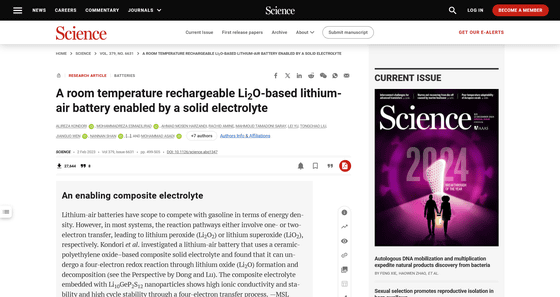Discovered solid electrolyte that enables lithium-air batteries to be charged at room temperature, theoretically enabling energy density comparable to that of gasoline

A room temperature rechargeable Li2O-based lithium-air battery enabled by a solid electrolyte | Science
https://www.science.org/doi/10.1126/science.abq1347

The solid electrolyte developed in this study is a composite material that incorporates Li 10 GeP 2 S 12 (LGPS) nanoparticles, discovered by Professor Ryoji Kanno 's group at the Tokyo Institute of Technology in 2011, into a polyethylene oxide (PEO) polymer. The LGPS nanoparticles provide high lithium ion conductivity while also enabling efficient ion transport at the interface with the polymer matrix, and the new solid electrolyte is said to exhibit ionic conductivity approximately 15 times higher than that of conventional electrolytes at room temperature.
In the experiment, a battery consisting of a lithium metal anode, the developed composite solid electrolyte, and a hydrophobic gas diffusion layer carrying Mo3P nanoparticles as a cathode showed stable performance over 1,000 cycles, exhibiting an energy efficiency of 92.7% at the first cycle and maintaining a high efficiency of 87.7% even after 1,000 cycles.

This new lithium-air battery can also operate in normal air, bringing it much closer to practical use in real-world environments. In discharge-charge experiments, the battery achieved a capacity of approximately 10.4mAh/cm2, which corresponds to an energy density of approximately 685Wh/kg by weight and approximately 614Wh/L by volume.
The team has demonstrated the feasibility of achieving energy densities of over 1 kWh/kg for their new lithium-air battery, significantly exceeding the capabilities of lithium-ion batteries and enabling a significant increase in the range of electric vehicles, matching or even exceeding that of current gasoline vehicles.

Furthermore, the solid electrolyte technology developed in this study is superior in terms of safety compared to conventional liquid electrolytes, and is expected to contribute to the development of safer next-generation batteries.
If this technology can be put to practical use, it is expected to accelerate the spread of electric vehicles and greatly contribute to decarbonization in the transportation sector. The research team states that it may also be used as an energy storage system necessary for the large-scale introduction of renewable energy, and that this technology is promising for realizing a sustainable energy society.

Related Posts:
in Science, Posted by log1i_yk







